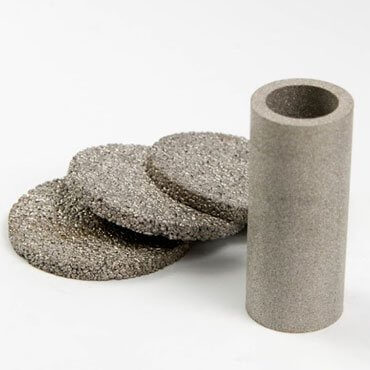Comparison of Sintered Metal Filters and Sintered Ceramic Filters

Hey, if you’re dealing with filtration in industry or labs, you’ve probably heard about sintered metal filters and sintered ceramic filters. Both are popular for cleaning up liquids, gases, or even air by trapping particles. They work by having tiny connected holes that let clean stuff pass through while holding back dirt. But which one fits your needs? In this post, we’ll break it down step by step. I’ll keep it straightforward, like we’re chatting over coffee, and explain each part in detail so you can follow along easily.
What Are Sintered Metal Filters?
Sintered metal filters start with fine metal powders, like stainless steel, bronze, or titanium. The process heats these powders to a high temperature without melting them fully. This bonds the particles together into a solid piece with uniform pores. The result is a tough filter that can handle rough conditions.
Let’s look at how they’re made. First, you mix the metal powder and press it into a shape, such as a tube, disc, or cartridge. Then, sintering happens in a furnace at around 70-80% of the metal’s melting point. For stainless steel, that’s about 1200 degrees Celsius. This creates pores of uniform size, often 0.5 to 100 microns. You can control the pore size by choosing powder grain size and pressure.
These filters shine in strength and durability. They withstand high pressures up to 30 bar and, in some cases, temperatures over 500 degrees Celsius. Cleaning is simple too – you can backwash them with water or air to remove trapped particles, and they last for years. Common uses include filtering oils in engines, gases in chemical plants, or even sterile air in pharma setups.
One big plus is their ability to hold a lot of dirt before clogging. The depth of the filter prevents particles from building up only on the surface. If you’re in a spot with corrosive fluids, pick titanium for extra resistance. Overall, these filters are reliable for heavy-duty jobs that require something that won’t break down quickly. For more on sintered powder metal filters, check out options from trusted makers.
What Are Sintered Ceramic Filters?
Sintered ceramic filters are made from ceramic powders such as alumina, zirconia, or silica. These are non-metal materials that get shaped and heated to form a hard, porous block. The sintering fuses the grains, leaving open channels for flow while blocking solids.
Making them is similar but uses higher heat. You start by mixing ceramic powder with water or binders to form a paste or slurry. Then, shape it via extrusion, pressing, or casting into forms like candles or plates. Drying removes moisture, and sintering at 1000-1600 degrees Celsius hardens it. Pore sizes range from 0.1 to 50 microns, and you get a very even distribution, which means consistent filtering.
Ceramics stand out for their heat and chemical tolerance. They handle temperatures up to 1000 degrees Celsius and resist acids, bases, and solvents that eat metals. They’re also biocompatible, so no leaching of harmful bits into your fluid. But they’re more brittle – they can crack under impact or high mechanical stress. Cleaning works with backwashing, though you must be gentle to avoid damage.
These filters often appear in food processing to remove bacteria, in water purification to produce clean drinking water, or in high-heat applications like smelting metals. Their uniform pores make them great for precise jobs, like catching tiny microbes. In short, go for ceramics when purity and resistance to harsh chemicals matter most, even if they’re not as tough as metal ones.
Similarities Between Sintered Metal Filters and Sintered Ceramic Filters
Both types share a lot since they use the same basic sintering method. For starters, they create porous structures with controlled hole sizes for effective filtration. You can adjust pores for different tasks, from coarse removal of big chunks to fine trapping of small particles.
They’re both reusable. Backwashing clears them out, cutting down on waste and costs over time. Manufacturing involves powder mixing, shaping, and high-heat bonding, so the end products have high void space – often 30-50% open area – for good flow rates without quick clogs.
In applications, they overlap in areas like chemical processing, where you filter corrosive liquids, or environmental control for air and water cleanup. Both meet strict standards for efficiency, often over 99% particle removal. And they’re inert enough for sensitive uses, though ceramics edge out in biocompatibility. If you need quality options, sites like NESIA Filter offer both types with solid specs.
Differences Between Sintered Metal Filters and Sintered Ceramic Filters
Now, let’s get to what sets them apart. Material is key: Metals like steel or bronze give flexibility and strength, while ceramics are rigid but prone to breaks. This means metal filters take high pressure and shocks better, up to 50 bar, versus ceramics at 10-20 bar max.
Temperature handling differs too. Ceramics win for extreme heat, over 800 degrees Celsius, ideal for furnaces or hot gases. Metals top out at 500-600 degrees but recover better from thermal cycles without cracking.
Chemical resistance flips the script. Ceramics laugh off strong acids and alkalis, while metals might corrode unless you pick alloys like titanium. Flow rates? Metals often run 20-40% faster due to their structure, but ceramics provide tighter control for ultra-fine filtration.
Cost and upkeep vary. Ceramics cost less upfront but may need more care to avoid damage. Metals are pricier but last longer in tough spots. Weight is another: Metals are heavier, ceramics lighter for easy install. Finally, metals conduct heat well for quick warm-ups, ceramics insulate better.
Applications and When to Choose Each Filter
Picking the right one depends on your setup. Use sintered metal filters for high-pressure systems, like hydraulic lines in machines or gas separation in oil refineries. They’re perfect for automotive fuel filters or pharma sterile venting, where durability and cleanability count.
Sintered ceramic filters fit corrosive or hot environments, such as wastewater treatment to kill germs or beer brewing for clear liquid. In labs, they’re go-tos for precise sample prep, and in metallurgy, they strain molten alloys.
For mixed needs, like moderate heat and chemicals, either works, but check flow and pressure specs. In food or meds, ceramics’ purity wins; for heavy industry, metal’s toughness. Always match to your media – test if possible. Budget-wise, start with ceramics for low-stress jobs, metals for long hauls.
Conclusion
So, sintered metal and ceramic filters both do great filtration work, but they suit different scenes. Metals bring strength and speed for demanding pressures, and ceramics offer heat and chemical shields for precise, safe tasks. Understanding these helps you avoid downtime or poor results. Next time you’re speccing a system, think about your conditions and pick smart. Got questions on setups? Drop a comment – happy to chat more.
WesternBusiness



